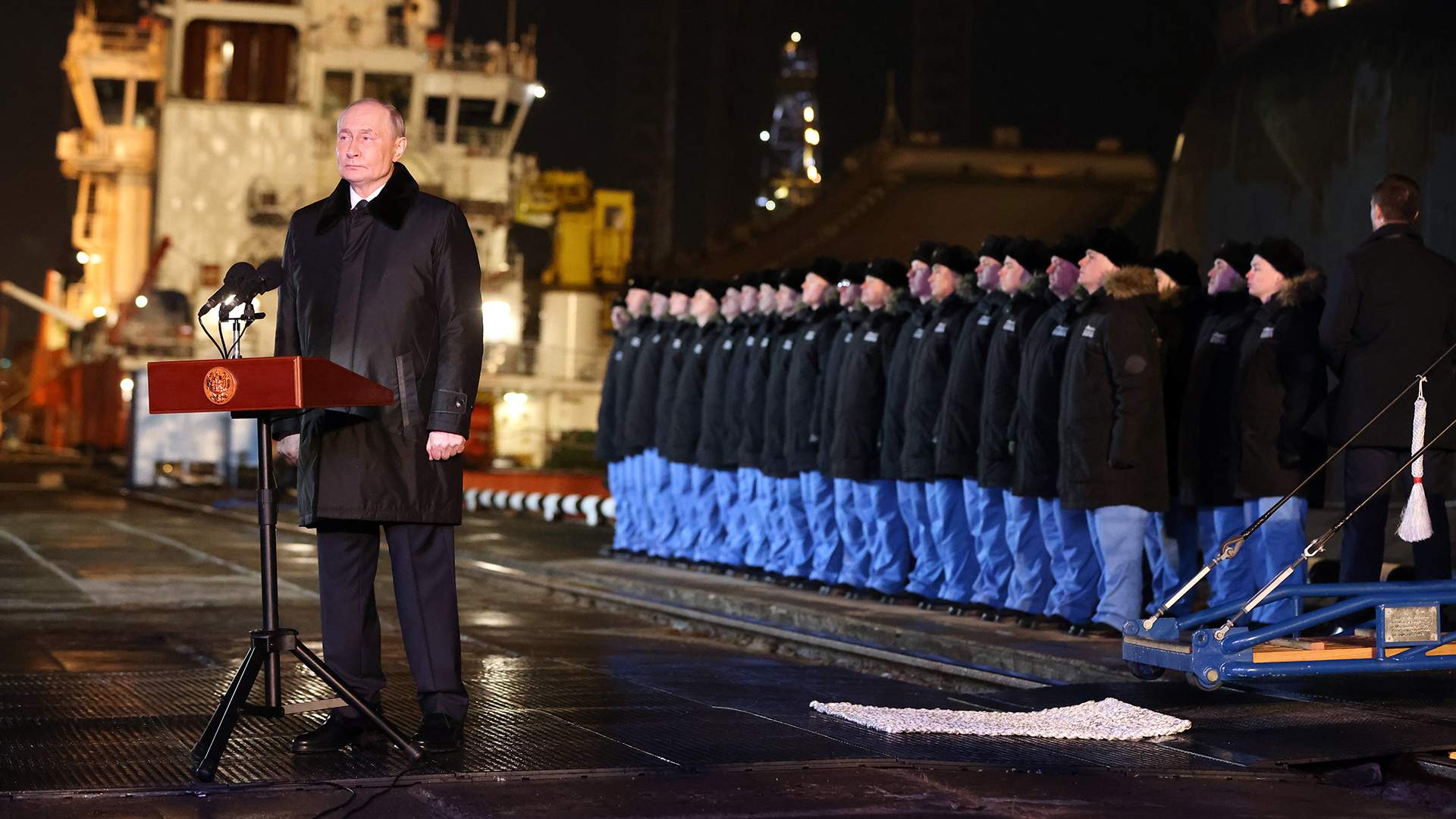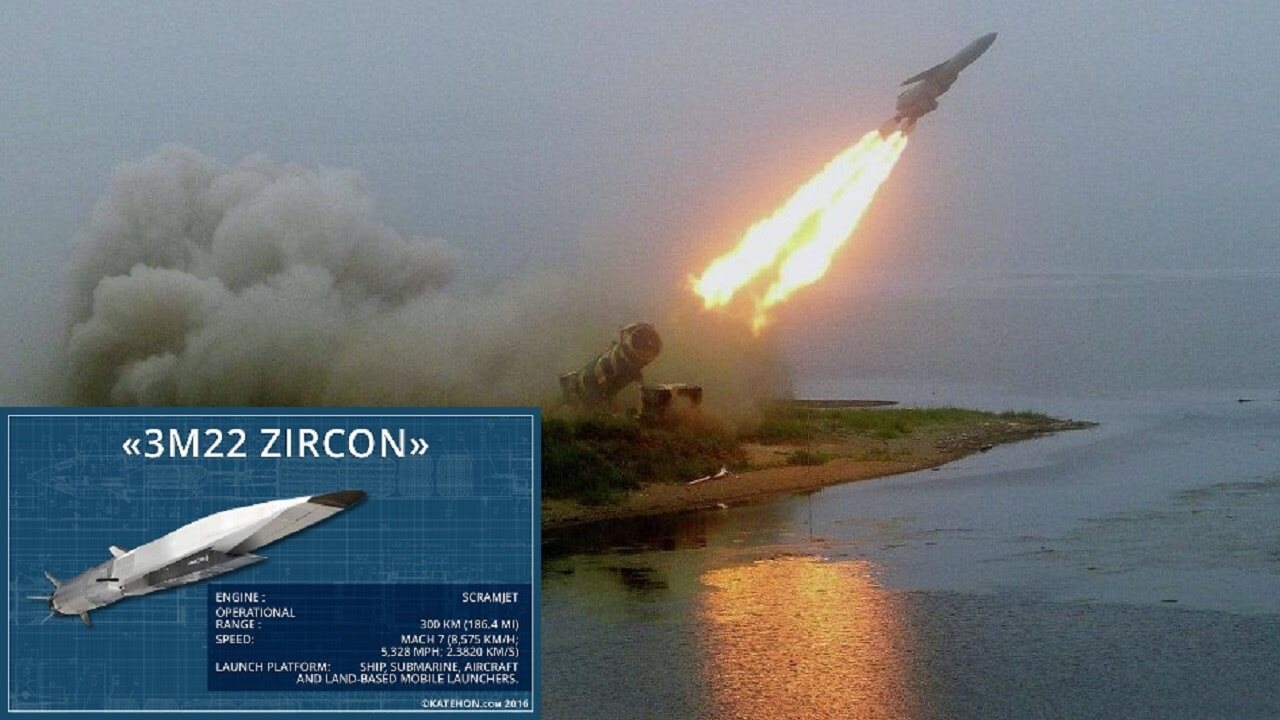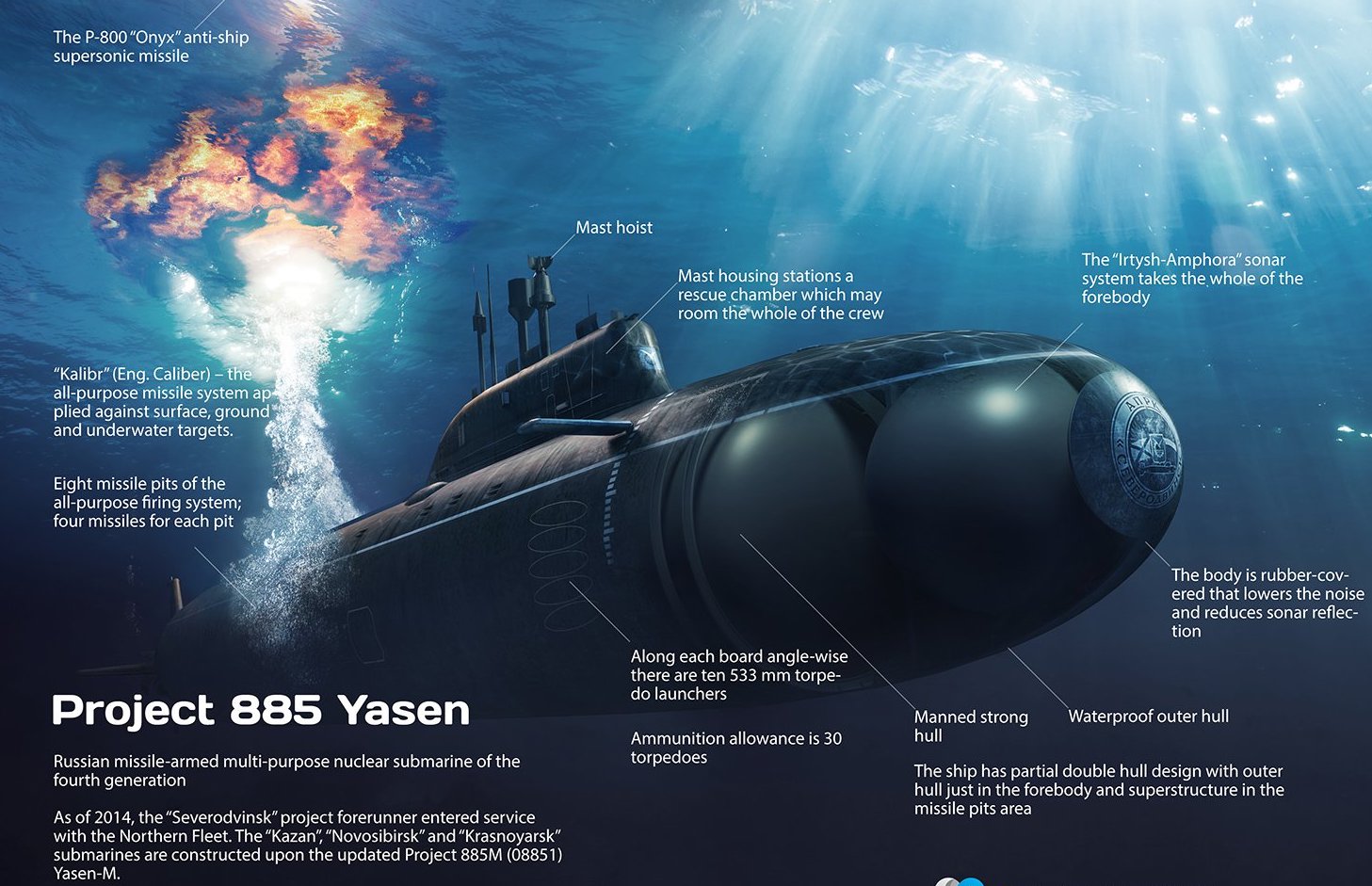Russian President Vladimir Putin launched the newest nuclear-powered Yasen-M class submarine, armed with hypersonic cruise missiles, at the Arctic port of Murmansk.
Speaking at the launching ceremony on March 27, President Putin said that the floating of the ‘Perm’ nuclear submarine, armed with a Tsirkon hypersonic cruise missile that can travel more than five times the speed of sound, was a milestone moment for the Russian Navy, TASS News Agency reported. “Go ahead!” the Russian leader said while green-lighting the launch of the newest Yasen-M class submarine.
Perm is the fifth in the Russian Navy’s Yasen-M class submarine series. The keel for its construction was laid in July 2016.
Putin announced that the submarine will enter service with the Russian Navy and take on combat tasks starting next year. “Yasen-M-class submarines are equipped with modern navigation, communication, and hydroacoustic systems. They carry high-precision weapons and are fitted with robotic equipment,” the Russian President said.”The Perm has become the first multipurpose submarine to carry Tsirkon hypersonic cruise missiles.”
Highlighting the submarine’s impeccable design and advanced features, the President thanked the designers and builders for their “scrupulous and high-quality work.” The Yasen-M class submarines are designed by the Malakhit Design Bureau of Marine Engineering in St. Petersburg and constructed at the Sevmash Shipyard.
The submarine has a partial double-hull design, with the outer hull in the forebody and the superstructure in the missile-pit area. Additionally, the body of the submarine is rubber-covered to lower noise and reduce sonar reflection, making it quieter. According to an infographic posted by Russian Embassy accounts on X, the mast housing of the submarine has a rescue chamber that can accommodate all of the crew.
The Russian Navy currently has one Yasen-class submarine, Severodvinsk, and four more advanced Yasen-M submarines: Kazan, Novosibirsk, Krasnoyarsk, and Arkhangelsk (launched in December 2024 after eleven months of extensive sea trials).
In addition to Perm, which will join service next year after testing, at least three more submarines—“Ulyanovsk”, “Voronezh”, and “Vladivostok” are currently under construction.

Russian President Putin called the launch of Perm a milestone event because it has been equipped with the Tsirkon hypersonic missiles, unlike the other previous subs of the class. According to reports in the Russian media, the design of this specific submarine has been slightly modified to integrate the missile.
While Russian officials have been insinuating that the Yasen/Yasen-M class of submarines will be equipped with the ‘invincible’ hypersonic missile, this is the first time the missile has been integrated into a submarine.
The Tsirkon missile, officially adopted by the Russian Navy in 2023, is a ship-launched missile that can travel more than five times the speed of sound.
President Putin announced the missile in 2018 as one of the five “wunderwaffe” weapons, along with the Avangard hypersonic glide vehicle, Poseidon nuclear-armed underwater unmanned vehicle, Burevestnik nuclear-powered cruise missile, and Kinzhal air-launched hypersonic missile.
Russian vessels armed with Tsirkon hypersonic missiles will challenge their adversaries by endangering their carrier battle groups.

Tsirkon is expected to threaten land targets and vital Western sea bases. The missile’s incredible speed would make it an excellent attack vector against larger vessels, as kinetic energy is the single best indicator of lethality against large surface targets (more so than warhead size). The kinetic energy of a hypersonic missile on impact will allow Russia to attack hardened, deep, and ground targets.
Boris Obnosov, CEO of Tactical Missiles Corporation, said in an interview with Rossiya-24 television that the missile can defeat nearly all air defense systems.
“For the time being, the characteristics of the Tsirkon system are extremely high, and, of course, a very effective anti-missile or air defense system is needed to intercept it. To me, at present, Tsirkon is a weapon that allows us to say that we can overcome any enemy defense,” the CEO said at the time.
Thus, integrating the missile on Russia’s quietest and most lethal submarine will significantly bolster Russia’s naval attack capability.
Russia’s Yasen Submarines Are Underwater Monsters
According to the Nuclear Threat Initiative, the Russian Navy had about 64 submarines as of August 2024, making it one of the largest submarine forces in the world. The number now reportedly stands at 66.
The 13,800-ton nuclear-powered cruise missile submarines Yasen and upgraded Yasen-M were introduced as part of the Kremlin’s efforts to modernize its Navy, replacing the nuclear attack submarines from the Soviet era.
The Yasen-M variant has a quieter nuclear reactor, additional sensors, and new quieting technology. It is considered crucial in enhancing Moscow’s naval might and strategic deterrence capabilities worldwide.
Since the Yasens are effectively cruise missile submarines, they are frequently assigned the unique vessel classification “SSGN” rather than “SSN.” The letter “G” stands for “guided missiles.” Analysts have noted in the past that the main Western counterparts of the Russian Yasen-M class, the Virginia Class of the US Navy, and the Astutes of the Royal Navy are significantly smaller than the Russian sub.
The strategic value of these submarines is enhanced by their capability to operate in a range of naval roles. The Yasen/Yasen-M subs are adaptable, multipurpose ships that can serve as intelligence gatherers, general-purpose attack boats, and potentially as special mission platforms.
The Yasen-class submarines were designed to engage carrier battle groups. They possess the capability to neutralize adversary ballistic missile submarines, attack submarines, and various other types of ships. Additionally, the Yasen-M variant can strike coastal targets like naval installations and ports, showcasing its versatile and formidable prowess. They are also responsible for protecting Russian nuclear-armed ballistic missile submarines.

These submarines can carry the (3M55) Onik missiles, which have a range of 320 nautical miles (592.64 kilometers), to attack hostile naval vessels and carriers. In contrast, the submarines employed for land attacks are equipped with Kalibr missiles, which have a range of 1,600 nautical miles (3963.2 km) (3M14K). The Oniks can also be used for land-attack missions. Besides these two lethal weapons, all the submarines of this class are likely to get the hypersonic Tsirkon missile.
However, at this juncture, only the Perm comes armed with Tsirkon.
Notably, Yasen-class submarines are believed to be among the world’s quietest in terms of capability, on par with the finest subs of its biggest adversary, the US Navy.
In 2021, General Glen VanHerck, the former chief of the US Northern Command (NORTHCOM), said that these submarines pose a growing threat to the American homeland, particularly as the class expands. Their quiet operation allows them to remain undetected, a key factor in their strategic advantage.
A Yasen-class submarine can launch these missiles from the mid-Atlantic and potentially strike targets along the US East Coast.
In June last year, the Yasen-M class submarine Kazan traveled to Cuba. It was widely reported to be stationed just 90 miles off Florida. At the time, the US dismissed the presence of the submarine as a threat to its security but dispatched its submarine USS Helena to Guantanamo Bay, as previously reported by the EurAsian Times.
Admiral Alexander Moiseev, Commander-in-Chief of the Russian Navy, said submariners “achieved high results in fulfilling the task of the Navy’s military presence in the World Ocean as part of the campaign of the lead ship of project 885M Kazan to the Republic of Cuba this year.”
Later, in November 2024, Japan’s Maritime Self-Defense Force (JMSDF) sighted a Russian Yasen-class nuclear-powered submarine near its waters, marking the first time an advanced Russian submarine sailed near Tokyo.
These submarines are still being integrated with advanced technology with every launch model. However, despite that, Edward Geist of the RAND Corporation in the United States has described them as “the crown jewel of the contemporary Russian Navy and perhaps the pinnacle of present-day Russian military technology. “
- Contact the author at sakshi.tiwari9555 (at) gmail.com
- Follow EurAsian Times on Google News




